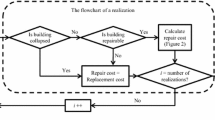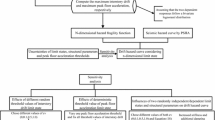Abstract
An active aftershock sequence, triggered by a large mainshock, can cause major destruction to urban cities. It is important to quantify the aftershock effects in terms of nonlinear responses of realistic structural models. For this purpose, this study investigates the aftershock effects on seismic fragility of conventional wood-frame houses in south-western British Columbia, Canada, using an extensive set of real mainshock-aftershock earthquake records. For inelastic seismic demand estimation, cloud analysis and incremental dynamic analysis are considered. A series of nonlinear dynamic analyses are carried out by considering different seismic input cases and different analysis approaches. The analysis results indicate that consideration of aftershocks leads to 5–20 % increase of the median inelastic seismic demand curves when a moderate degree of structural response is induced. The findings of this investigation facilitate the extension of the existing approaches for inelastic seismic demand estimation to incorporate the aftershock effects.













Similar content being viewed by others
References
Atkinson GM, Goda K (2011) Effects of seismicity models and new ground-motion prediction equations on seismic hazard assessment for four Canadian cities. Bull Seismol Soc Am 101:176–189
Baker JW, Cornell CA (2005) A vector-valued ground motion intensity measure consisting of spectral acceleration and epsilon. Earthq Eng Struct Dyn 34:1193–1217
Baker JW, Cornell CA (2006) Correlation of response spectral values for multicomponent ground motions. Bull Seismol Soc Am 96:215–227
Baker JW (2011) The conditional mean spectrum: a tool for ground motion selection. J Struct Eng 137:322–331
Christovasilis IP, Filiatrault A, Constantinou MC, Wanitkorkul A (2009) Incremental dynamic analysis of woodframe buildings. Earthq Eng Struct Dyn 38:477–496
Cornell CA, Jalayer F, Hamburger RO, Foutch DA (2002) Probabilistic basis for 2000 SAC Federal Emergency Management Agency steel moment frame guidelines. J Struct Eng 129:526–533
Folz B, Filiatrault A (2001) Cyclic analysis of wood shear walls. J Struct Eng 127:433–441
Folz B, Filiatrault A (2004) Seismic analysis of woodframe structures I: model formulation. J Struct Eng 130:1353–1360
Goda K, Atkinson GM (2009) Probabilistic characterization of spatially-correlated response spectra for earthquakes in Japan. Bull Seismol Soc Am 99:3003–3020
Goda K, Atkinson GM (2011) Seismic performance of wood-frame houses in south-western British Columbia. Earthq Eng Struct Dyn 40:903–924
Goda K (2012) Nonlinear response potential of mainshock-aftershock sequences from Japanese earthquakes. Bull Seismol Soc Am 102:2139–2156
Goda K, Taylor CA (2012) Effects of aftershocks on peak ductility demand due to strong ground motion records from shallow crustal earthquakes. Earthq Eng Struct Dyn 41:2311–2330
Goda K, Pomonis A, Chian SC, Offord M, Saito K, Sammonds P, Fraser S, Raby A, Macabuag J (2013) Ground motion characteristics and shaking damage of the 11th March 2011 \(M_{{\rm w}}9.0\) Great East Japan earthquake. Bull Earthq Eng 11:141–170
Goulet CA, Haselton CB, Mitrani-Reiser J, Beck JL, Deierlein GG, Porter KA, Stewart JP (2007) Evaluation of the seismic performance of a code-conforming reinforced-concrete frame building—from seismic hazard to collapse safety and economic losses. Earthq Eng Struct Dyn 36:1973–1997
Iervolino I, Cornell CA (2005) Record selection for nonlinear seismic analysis of structures. Earthq Spectra 21:685–713
Iervolino I, Cornell CA (2008) Probability of occurrence of velocity pulses in near-source ground motions. Bull Seismol Soc Am 98:2262–2277
Iervolino, I., Giorgio, M., Chioccarelli, E. (2013) Closed-form aftershock reliability of damage-cumulating elastic-perfectly-plastic systems. Earthq Eng Struct Dyn (in press; doi:10.1002/eqe.2363)
Jalayer F, Asprone D, Prota A, Manfredi G (2011) A decision support system for post-earthquake reliability assessment of structures subjected to aftershocks: an application to L’Aquila earthquake, 2009. Bull Earthq Eng 9:997–1014
Li Q, Ellingwood BR (2007) Performance evaluation and damage assessment of steel frame buildings under mainshock-aftershock earthquake sequence. Earthq Eng Struct Dyn 36:405–427
Luco N, Bazzurro P (2007) Does amplitude scaling of ground motion records result in biased nonlinear structural drift responses? Earthq Eng Struct Dyn 36:1813–1835
Luco N, Cornell CA (2007) Structure-specific scalar intensity measures for near-source and ordinary earthquake ground motions. Earthq Spectra 23:357–392
Luco, N., Bazzurro, P., Cornell, C.A. (2004) Dynamic versus static computation of the residual capacity of a mainshock-damaged building to withstand an aftershock. In: 13th World conference on earthquake engineering, Vancouver, Canada, paper no. 2405
PEER Ground Motion Selection and Modification (GMSM) Working Group (2009) Evaluation of ground motion selection and modification methods: predicting median interstory drift response of buildings. PEER Report 2009/01, University of California at Berkeley, Berkeley, CA
Ruiz-García J (2012) Mainshock-aftershock ground motion features and their influence in building’s seismic response. J Earthq Eng 16:719–737
Ryu H, Luco N, Uma SR, Liel AB (2011). Developing fragilities for mainshock-damaged structures through incremental dynamic analysis. In: 9th Pacific conference on earthquake engineering, Auckland, New Zealand, paper no. 225
Shcherbakov R, Turcotte DL, Rundle JB (2005) Aftershock statistics. Pure Appl Geophys 162:1051–1076
Shcherbakov R, Nguyen M, Quigley M (2012) Statistical analysis of the 2010 \(M_{{\rm w}}~7.1\) darfield earthquake aftershock sequence. N Z J Geol Geophys 55:305–311
Tothong P, Luco N (2007) Probabilistic seismic demand analysis using advanced ground motion intensity measures. Earthq Eng Struct Dyn 36:1837–1860
Vamvatsikos D, Cornell CA (2004) Applied incremental dynamic analysis. Earthq Spectra 20:523–553
Ventura CE, Finn WDL, Onur T, Blanquera A, Rezai M (2005) Regional seismic risk in British Columbia—classification of buildings and development of damage probability functions. Can J Civ Eng 32:372–387
Wen YK, Ellingwood BR (2005) The role of fragility assessment in consequence-based engineering. Earthq Spectra 21:861–877
White TW, Ventura CE (2006) Seismic performance of wood-frame residential construction in British Columbia—technical report. Earthquake Eng. Research Facility Report No. 06–03, University of British Columbia, Vancouver, Canada
Yeo GL, Cornell CA (2009) A probabilistic framework for quantification of aftershock ground-motion hazard in California: methodology and parametric study. Earthq Eng Struct Dyn 38:45–60
Yin YJ, Li Y (2011) Loss estimation of light-frame wood construction subjected to mainshock-aftershock sequences. J Perform Constr Facil 25:504–513
Zhai CH, Wen WP, Chen ZQ, Li S, Xie LL (2013) Damage spectra for the mainshock-aftershock sequence-type ground motions. Soil Dyn Earthq Eng 45:1–12
Acknowledgments
The authors thank an anonymous reviewer for providing insightful and constructive comments on the original manuscript, which led to significant improvement of the manuscript. The financial support provided through the Philip Leverhulme Prize is gratefully acknowledged. Strong ground-motion data were obtained from the PEER-NGA database (http://peer.berkeley.edu/nga/), the K-NET at www.k-net.bosai.go.jp, and the KiK-net at www.kik.bosai.go.jp.
Author information
Authors and Affiliations
Corresponding author
Rights and permissions
About this article
Cite this article
Goda, K., Salami, M.R. Inelastic seismic demand estimation of wood-frame houses subjected to mainshock-aftershock sequences. Bull Earthquake Eng 12, 855–874 (2014). https://doi.org/10.1007/s10518-013-9534-4
Received:
Accepted:
Published:
Issue Date:
DOI: https://doi.org/10.1007/s10518-013-9534-4




